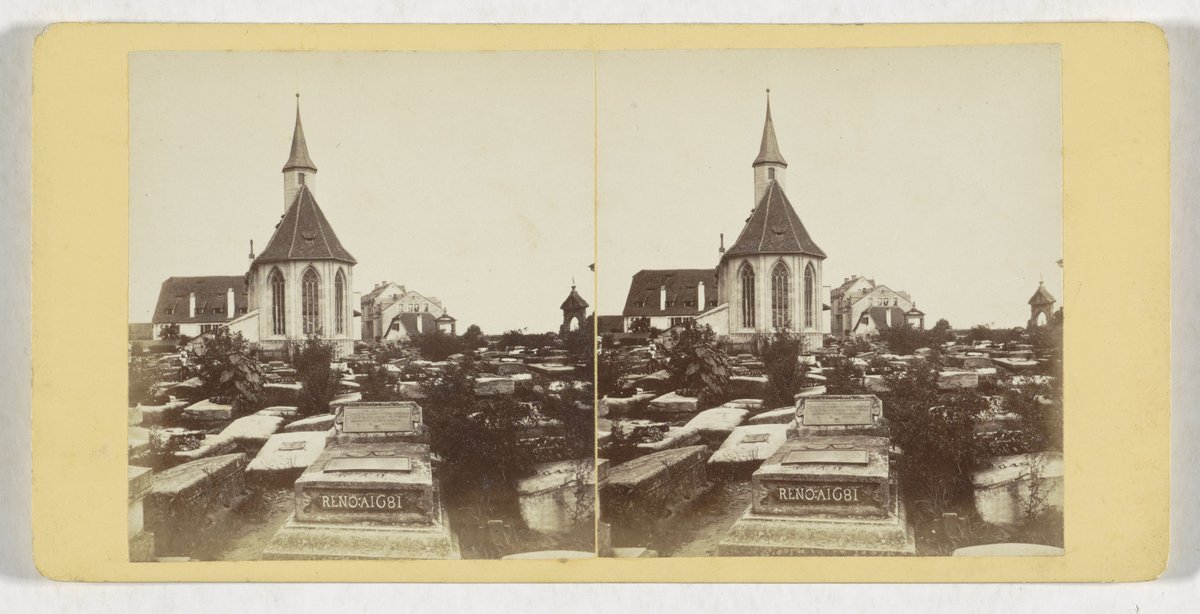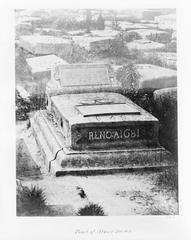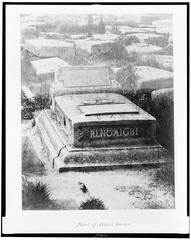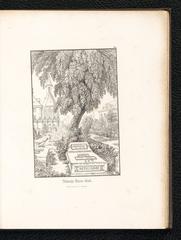
Albrecht Dürer Grave Visiting Hours, Tickets, and Nuremberg Historical Sites Guide
Date: 14/06/2025
Introduction
Albrecht Dürer, born in 1471 in Nuremberg, Germany, is widely regarded as a master of the Northern Renaissance. His innovations in painting, printmaking, and artistic theory left a profound legacy that continues to resonate in the art world today. Visiting Dürer’s grave at Johannisfriedhof (St. John’s Cemetery) in Nuremberg offers an intimate connection to the artist and a gateway to the city’s rich cultural landscape. This guide provides comprehensive practical information for visiting Dürer’s grave, including opening hours, ticketing details, accessibility, and tips for exploring nearby Nuremberg historical sites. Whether you are an art connoisseur, history enthusiast, or cultural traveler, this article will help you plan a meaningful visit.
Sources for this guide include the Nuremberg Museum, Nuremberg Tourism Office, and Atlas Obscura.
Contents
- Introduction
- Historical Background
- Albrecht Dürer: Life and Legacy in Nuremberg
- The Grave of Albrecht Dürer: Historical Context
- Commemoration and National Significance
- The Role of St. John’s Cemetery in Nuremberg’s Heritage
- Visiting Albrecht Dürer’s Grave: Practical Information
- Visiting Hours and Tickets
- Accessibility
- How to Get There
- Best Times to Visit
- Guided Tours and Special Events
- Nearby Attractions
- Facilities and Amenities
- Safety and Security
- Accessibility for International Visitors
- Description of Dürer’s Grave
- Location and Layout
- Physical Features
- Inscriptions, Plaques, and Epitaph
- Artistic and Cultural Significance
- Practical Tips for a Meaningful Visit
- Frequently Asked Questions (FAQ)
- Suggested Visuals and Media
- Internal and External Links
- Call to Action
- Conclusion
Historical Background
Albrecht Dürer: Life and Legacy in Nuremberg
Albrecht Dürer (1471–1528) was a pivotal figure in the Northern Renaissance. Born and raised in Nuremberg, Dürer benefited from the city’s vibrant economic and cultural life, which fostered his growth as an artist. Initially trained as a goldsmith, Dürer soon shifted his focus to painting and printmaking, drawing influence from both German and Italian masters. He established a renowned workshop in Nuremberg, producing groundbreaking woodcuts, engravings, and paintings that garnered acclaim across Europe (Art UK, albrecht-durer.org). Dürer’s relationship with the Holy Roman Emperor Maximilian I further elevated his status, and his theoretical treatises on mathematics and proportion contributed to his reputation as a Renaissance polymath.
The Grave of Albrecht Dürer: Historical Context
Dürer died in 1528 and was buried at Johannisfriedhof, a cemetery established in the early 16th century just outside Nuremberg’s city walls. The cemetery is known for its orderly rows of flower-topped graves, distinctive sandstone tombs, and ornate bronze plaques (quartiere-nuernberg.de). Dürer’s grave, marked by a simple sarcophagus with inscriptions composed by his friend Willibald Pirckheimer, quickly became a pilgrimage site for artists and admirers.
Commemoration and National Significance
In 1828, on the 300th anniversary of Dürer’s death, Nuremberg honored him with a grand celebration and the foundation of the Albrecht Dürer Monument—the first artist monument in Germany (tourismus.nuernberg.de). Today, both the grave and the monument symbolize the city’s recognition of Dürer’s enduring influence on art and culture (quartiere-nuernberg.de).
The Role of St. John’s Cemetery in Nuremberg’s Heritage
St. John’s Cemetery is not only Dürer’s final resting place but also a significant testament to the city’s past. Established in 1518, it features rows of historical graves, many with intricate carvings and bronze nameplates, and is renowned as one of Germany’s most beautiful cemeteries (quartiere-nuernberg.de).
Visiting Albrecht Dürer’s Grave: Practical Information
Visiting Hours and Tickets
- Opening Hours:
- April–September: 7:00–20:00
- October–March: 8:00–18:00
- Note: Hours may vary due to weather or special events.
- Admission:
- Entry to the cemetery and Dürer’s grave is free of charge; no tickets are required.
Accessibility
- Cemetery paths are mostly flat and paved, with some cobblestones and gentle slopes.
- Wheelchair access is generally possible, but assistance may be needed in older sections.
How to Get There
- Address: Johannisfriedhof, Johannisstraße 160, 90419 Nuremberg, Germany.
- Walk: Approximately 20–25 minutes from Hauptmarkt (central Old Town).
- Tram: Lines 4 or 6 to “Johannisfriedhof” stop.
- Public transport is included with the Nuremberg Card (The Geographical Cure).
- Limited parking is available; public transport or walking is recommended.
Best Times to Visit
- Early morning or late afternoon provides a peaceful ambiance and optimal photography light.
- Spring and early summer are especially beautiful due to blooming flowers.
Guided Tours and Special Events
- Guided tours are available seasonally or during special events, such as the annual Dürer Lectures (ArtHist.net).
- Check with Nuremberg Tourism Office or Nuremberg Municipal Museums for current offerings and schedules.
Facilities and Amenities
- Restrooms are located near the entrance.
- No cafés or shops within the cemetery, but options are available in the surrounding Johannis district.
- For souvenirs, visit the Albrecht Dürer House Museum shop or the Germanisches Nationalmuseum shop.
Safety and Security
- The cemetery is situated in a safe residential area.
- Keep personal belongings secure and be aware of closing times.
Accessibility for International Visitors
- Most signage is in German, but Dürer’s grave is well-marked.
- English-language materials are available through the tourism office and guidebooks.
- The cemetery is featured in many self-guided walking tour itineraries (The Adventure Lion).
Description of Dürer’s Grave
Location and Layout
- Dürer’s grave can be found in Section 5, Grave 649 of Johannisfriedhof (Nuremberg Museum).
- The cemetery is laid out in orderly rows with lush plantings and bronze nameplates.
Physical Features
- The grave is a rectangular stone sarcophagus, adorned with bronze plaques and the crests of the Frey and Rummel families (Dürer’s in-laws).
- Originally established as a family grave, it includes Dürer, his mother-in-law Anna Frey, and his father-in-law Hans Frey.
Inscriptions, Plaques, and Epitaph
- Oblique Inscription: Composed by Willibald Pirckheimer, Dürer’s close friend—“What was mortal of Albrecht Dürer lies beneath this mound.”
- Horizontal Bronze Plaque: Added in 1681, with inscriptions in Latin and German.
- Coat of Arms: The Frey and Rummel family crests signify the family connection.
- Additional words on the tomb reference Dürer’s mastery: “SCULPTURA,” “PICTURA,” and “ARCHITEC.”
 Alt text: Albrecht Dürer’s grave stone sarcophagus with bronze plaques surrounded by greenery at Johannisfriedhof in Nuremberg
Alt text: Albrecht Dürer’s grave stone sarcophagus with bronze plaques surrounded by greenery at Johannisfriedhof in Nuremberg
Artistic and Cultural Significance
Dürer’s grave is a site of pilgrimage for art lovers and scholars. His profound influence on Renaissance printmaking, painting, and art theory established new standards for European art (Explorial). The grave’s preservation, commemorative plaques, and continued academic events such as the Dürer Lectures underscore its cultural importance (Nuremberg Museum, ArtHist.net).
Practical Tips for a Meaningful Visit
- Combine Sites: Visit the Albrecht Dürer House Museum and Germanisches Nationalmuseum for a deeper understanding of Dürer’s impact (Time Travel Turtle).
- Events: Plan your visit around special events for guided tours and lectures.
- Etiquette: Maintain quiet respect; photography is allowed but should be discreet.
- Duration: Allocate 30–45 minutes for the cemetery; more if exploring nearby graves or relaxing on benches.
- Weather: The cemetery is outdoors—dress accordingly.
Exploring Nearby Attractions and Things to Do
- Albrecht Dürer House: Museum in Dürer’s former residence (Explorial), European Traveler.
- Dürer-Hase Skulptur: Bronze sculpture near Tiergärtnertorplatz (Explorial).
- Imperial Castle (Kaiserburg): Medieval fortress with panoramic views (MyTravelation).
- St. Sebaldus Church: Gothic church with the tomb of St. Sebaldus.
- Weissgerbergasse: Picturesque street with half-timbered houses (Rick Steves Community, TravelSetu).
- Germanisches Nationalmuseum: Germany’s largest cultural history museum (MyTravelation).
- Documentation Center Nazi Party Rally Grounds and Nuremberg Trials Memorial: Key 20th-century historical sites (Roam and Thrive).
Frequently Asked Questions (FAQ)
Q: What are the opening hours for Albrecht Dürer’s grave?
A: Johannisfriedhof is open daily from 7:00 or 8:00 AM until 6:00 or 8:00 PM, depending on season. Confirm current hours on the Nuremberg Tourism Office website.
Q: Is there an admission fee?
A: No, entry to the cemetery and Dürer’s grave is free.
Q: Are guided tours available?
A: Yes, seasonally and for special events—check with local tourism offices or museums.
Q: Is the site wheelchair accessible?
A: Generally yes, but some uneven terrain exists; assistance may be needed.
Q: Can I take photographs?
A: Yes, but please be discreet and respectful.
Suggested Visuals and Media
- High-quality images of Dürer’s grave and St. John’s Cemetery paths (with descriptive alt texts).
- Maps showing the location of Johannisfriedhof and major nearby attractions.
- Virtual tour links or interactive guides.
- Photos of the Albrecht Dürer House and Dürer-Hase Skulptur.
Internal and External Links
- Nuremberg Museum
- Nuremberg Tourism Office
- Atlas Obscura
- Albrecht Dürer House Museum
- Germanisches Nationalmuseum
- Rick Steves Community
- ArtHist.net
Call to Action
Enhance your visit to Nuremberg by downloading the Audiala app for in-depth audio tours of Albrecht Dürer’s grave and other historical sites. Follow us on social media for the latest updates and explore related articles for expert travel tips and historical insights.
Conclusion
Visiting Albrecht Dürer’s grave at Johannisfriedhof is a deeply enriching experience that connects you to the legacy of a Renaissance master and the historical heart of Nuremberg. With free access, practical amenities, and a wealth of nearby attractions, the site is welcoming to all visitors. Immerse yourself in Nuremberg’s artistic heritage and honor Dürer’s enduring impact on art and culture.
References
- Visiting Albrecht Dürer’s Grave in Nuremberg: History, Hours, and Travel Tips, 2024, Quartiere Nürnberg
- Visiting Albrecht Dürer’s Grave: Hours, Tickets, and Nuremberg Historical Sites Guide, 2024, Nuremberg Museum
- Visiting Albrecht Dürer’s Grave in Nuremberg: Hours, Tickets, and Travel Tips, 2024, Nuremberg Tourism Office
- Visiting Albrecht Dürer’s Grave in Nuremberg: Hours, Tickets, and Nearby Historical Attractions, 2024, MyTravelation
- Dürer’s Grave at Johannisfriedhof, 2024, Atlas Obscura
- Ten Things to Know About Albrecht Dürer, 2024, Art UK
- Best Albrecht Dürer Sites in Nuremberg, 2024, The Adventure Lion
- Discovering Dürer’s Tomb in Nuremberg, 2024, Tourist Platform
- Nuremberg Tips, 2024, Rick Steves Community
- Nuremberg Historical Sites Overview, 2024, Roam and Thrive
- Albrecht Dürer House Museum Guide, 2024, European Traveler
- Albrecht Dürer Legacy and Cultural Heritage, 2024, ArtHist.net


















































